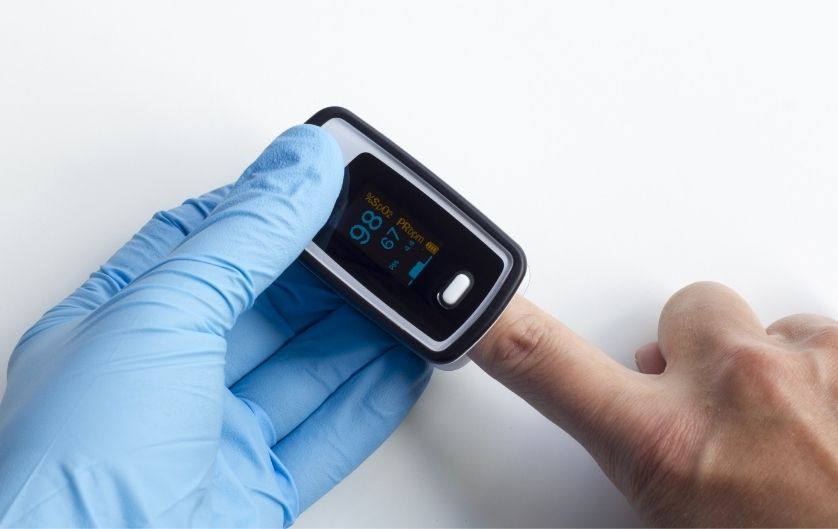Your cart is empty now.

Normal Readings on a Pulse Oximeter | CMI Health
Pulse oximetry has become so prevalent in the healthcare world that it is often regarded as one of the five major vital signs for understanding a person’s overall health (Chan et al. 2013). Due to the high importance placed on our everyday blood oxygen levels, it is important to understand what constitutes a normal SpO2 reading, along with average pulse rates. Continue reading to learn about the normal readings on a pulse oximeter and how to use them to gage your health.
What is SpO2?
Pulse oximetry functions by using light absorption principles. Essentially, the probe placed on your finger is capable of measuring the difference in light wave absorption between oxygenated and deoxygenated blood (Healthline, 2017). Fingers (or toes in the case of an infant) are an effective location for SpO2 measurement due to the high vascular density of the region (Chan et al. 2013). Because of this, finger probe readings should be consistent with the SpO2 levels of the rest of your body.
So, what readings should you normally expect to see?
Unlike pulse rate, age does not generally affect normal, healthy SpO2 levels. On average, and healthy blood oxygen percentage should read between 95%-100%. Depending on your condition, it may average below this percentage range. Even so, it is usually dangerous for it to fall below 90%. In such cases, it may be necessary to contact your local physician.
Please be advised that not everyone falls under these guidelines, and it may be necessary to consult a medical professional to determine your individual normal range.
What is Pulse Rate?
Pulse rate is a simple yet important measurement that can tell a lot about a person’s overall physical health. Several factors including age, fitness, medication, body size, and physical wellness can affect a person’s average resting heart rate.
For adults, a normal resting heart rate can be anywhere from 60-100 BPM (Mayo Clinic, 2020). Athletes may fall below this average at around 40-50 BPM. Infants and children generally have a faster pulse rate due to their smaller size—which can result in an average BPM range of 80-130. As they progress in age, their pulse tends to slow. Overall, pulse rate averages can vary drastically when compared to variation in SpO2 levels.
Clinical (COPD, Sleep apnea)
In some cases, normal readings on a pulse oximeter can fluctuate depending on medical diagnosis. In adults with COPD or sleep apnea, normal SpO2 levels may be lower than in a healthy adult. Using a continuous pulse oximetry monitor can help those diagnosed with such conditions to monitor their health—one of the many reasons to have a pulse oximeter at home.
It is particularly wise to utilize a device with a programmable threshold that allows the user to adjust the limitations based on their personal health. This will ensure that the alarm is only triggered when the user’s pulse rate or SpO2 levels dip below a percentage that is deemed dangerous by their personal physician. According to one scientific journal, "Pulse oximetry represents a useful diagnostic adjunct for assessing the severity of obstructive pulmonary diseases" (Dalbak et al, 2015). As such, if you want to stay on-track with your current health, this form of monitoring is essential.
What can a low pulse rate and SPO2 mean (and what causes them)?
An ongoing low pulse rate, also known as bradycardia, can be very dangerous. It may signify that your heart is not pumping enough oxygen-rich blood to the rest of your body, which can cause dizziness, lethargy, and shortness of breath. This can cause vital organs to function improperly, which over time may lead to cardiac arrest, angina, and high blood pressure (Mayo Clinic, 2021)
Low pulse rate can be attributed to a variety of factors including age, low physical activity, body size, and other personal health attributes. Even so, continuously low pulse rate may also be caused by deficiencies within the heart ventricle system, or may be side effects caused by antidepressants, heart medications, and opioid drugs. (Michigan Medicine, 2021)
SPo2 readings measure the percentage of oxygenated red blood cells in a user’s arteries. Monitoring your SpO2 levels is important because without a healthy amount of oxygenated blood cells, the body experiences hypoxemia. Over time, hypoxemia may cause muscles and organs to shut down and damage healthy blood cells. The brain is most susceptible to the effects of hypoxia which is why it is especially important to be aware of SpO2 levels (Leader, 2021) For more information on hypoxia and hypoxemia, click here!
Normal SpO2 levels can differ greatly between individuals, so the causes of low SpO2 levels can vary from person to person. For the most part, however, low SpO2 levels are often caused by heart defects, lung illnesses such as asthma and bronchitis, strong pain medications, sleep apnea, inflammation or scarring of lung tissue, and being at a high altitude for long periods of time. Symptoms of low SpO2 levels can be headaches, shortness of breath, bluish hue in skin tone and fast heartbeat (Cleveland Clinic, 2021)
Interested in purchasing your own handheld pulse oximeter? View our collection of easy to use, clinical grade monitoring devices here.



